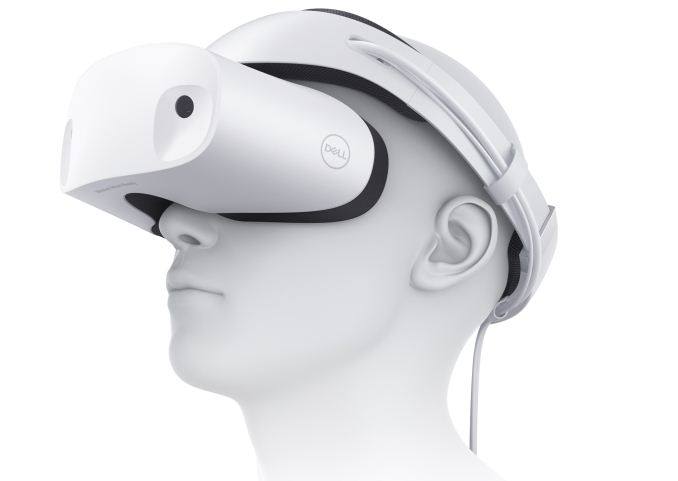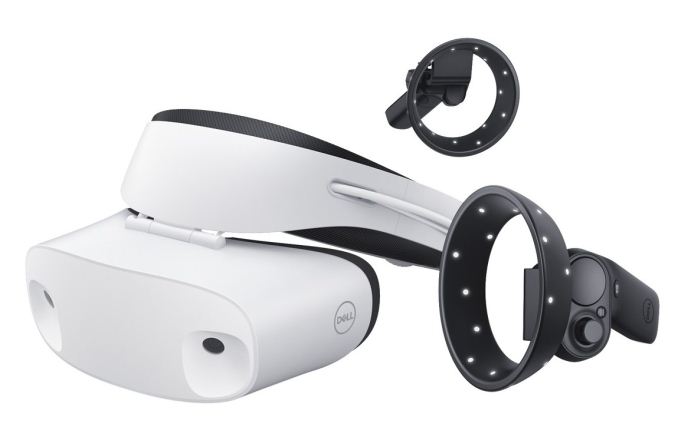Dell Enters VR Arena With "Visor" HMD
by Ryan Smith on August 29, 2017 3:00 PM EST- Posted in
- VR
- Dell
- Trade Shows
- Visor
- Windows Mixed Reality
- IFA 2017

This week, Dell is announcing its own version of a virtual reality head mounted display (VR HMD) at IFA, the Dell Visor. With their first VR product, Dell is joining the ranks of other mainstream manufacturers that are adopting Microsoft’s Windows Mixed Reality platform to bring an HMD to market.
The Dell Visor features two 90Hz 1440 x 1440 LCD panels (for a total resolution of 2880 x 1440) that can “flip up” to let you see the real world around you without completely removing the headset. The faceplate is well cushioned, and the headband is easily adjusted using a thumbwheel. The company claimed that it's comfortable to wear, even with glasses, but like other VR headsets, this will likely vary from person to person.
Similar to Acer’s Mixed Reality HMD, the Dell Visor is a tethered headset (USB and HDMI cable) that connects to a Windows PC (with at least the baseline specifications) and features inside-out 6DoF tracking; the headset doesn’t require external cameras or lighthouses to track its position in space. Boundaries are setup by outlining the play area with the HMD, but maximum tracking space wasn’t disclosed.
When asked what the main difference between the Dell Visor and its competition was, a representative explained, “Ours is white.” Indeed, the Visor features a white (almost Apple-esque) finish, with an anti-stain coating to keep it clean. The representative went on to explain that Dell’s design keeps comfort and convenience in the forefront, evidenced by the flip-up display, ergonomic headband, and gratuitous face padding. The company hopes that this will be enough to differentiate the Visor in an ever-growing field of VR HMDs.
The Dell Visor doesn’t ship with a controller of any kind, but it’s compatible with Microsoft’s new Mixed Reality Controllers, which are tracked by the headset’s external sensors. Dell is offering the headset for $349.99, and you can order the controllers with them for another $99.99. For reference, the Acer HMD plus controllers bundle is $400.
The Dell Visor is expected to arrive mid-October.
Derek Forrest contributed to this report
Source: Dell











16 Comments
View All Comments
edzieba - Tuesday, August 29, 2017 - link
It's sad to see all the Windows Holographic HMDs launching with singlet lenses and full-persistence LCD panels. This is DK1-era stuff, bringing that to market now shouldn't even be considered an option.edzieba - Tuesday, August 29, 2017 - link
I should probably elaborate: singlet lenses mean that viewing off-axis (i.e. looking anywhere other than directly ahead) will cause the view to blur from multiple different optical effects (mostly chromatic, spherical, and field-curvature). If the lenses are not adjustable for IPD, you get the double-whammie that if your IPD does not happen to match the lens separation, you will /never/ get a non-distorted view for both eyes.Full-persistance displays will blur whenever your head moves. To explain why, I'll defer to Michael Abrash's 2013 blog post: http://blogs.valvesoftware.com/abrash/down-the-vr-...
CrymsonKyng - Tuesday, August 29, 2017 - link
I suspect that corners had to be cut in order to meet pricing requirements. Microsoft is pushing these sets, and also baseline pricing. I suspect we will not see true next gen sets until the market has matured a bit, or oem's see enough volume to justify the development costs of a better set. Remember, these are competing with the Rift, the Vive, and the PSVR(which has been the value set up to this point).These sets will probably end up as Xbox One X compatible as well, so pricing needs to reflect what the console market will bear.
edzieba - Wednesday, August 30, 2017 - link
Which still doesn't cut it: PSVR (inc. controllers) is $450, matching this HMD but with a superior OLED panel, and the (current sale price) Rift is at $400 (also inc. controllers), undercutting it AND offering superior hardware.HomeworldFound - Tuesday, August 29, 2017 - link
I really don't see people wearing this.ddriver - Tuesday, August 29, 2017 - link
Yeah, direct retinal projection or GTFO. At the very least, direct neural interface would be much better. Not to mention the astronomical possibilities for abuse.HomeworldFound - Wednesday, August 30, 2017 - link
Go full Ghost in the Shell mode. I want to hack brainz.HomeworldFound - Wednesday, August 30, 2017 - link
By the way I mean the anime not the crappy movie.Manch - Wednesday, August 30, 2017 - link
That's bc it's not mid October...ddriver - Tuesday, August 29, 2017 - link
They should definitely make that padding that goes onto the user's face removable and washable. Last year there were numerous cases of mass eye herpes infections on public events from chumps sharing VR and AR headsets. You should not be doing that, same thing as with needles. User replaceable padding would mitigate that issue as the pads can be quickly changed, washed and whatnot. Although it will certainly hurt the "reality aspect" of it, I mean you could not say "VR sex is so real it gave me herpes".